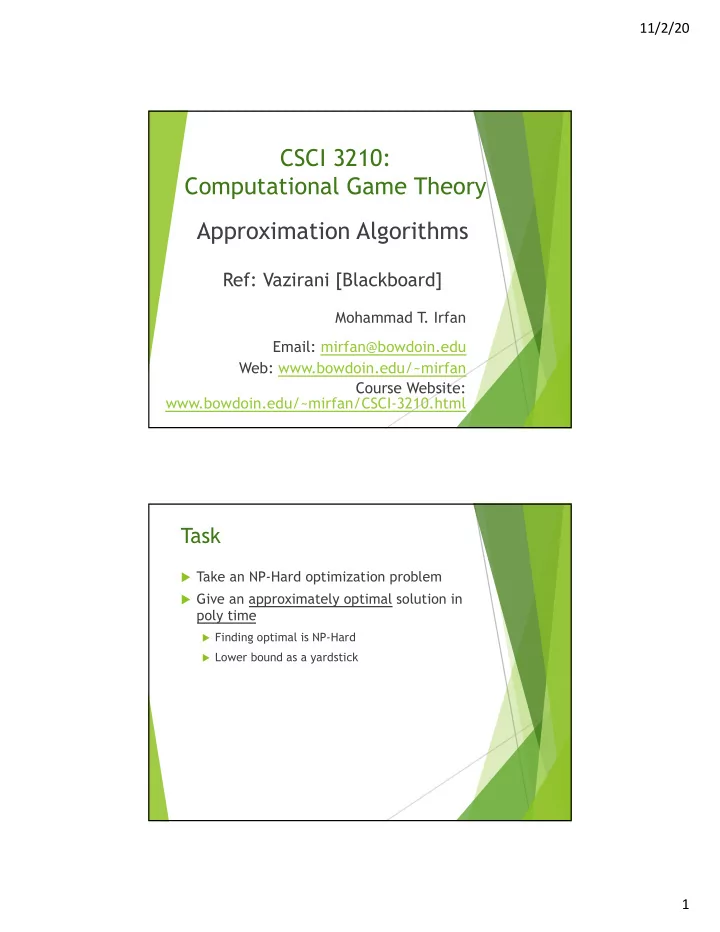

11/2/20 CSCI 3210: Computational Game Theory Approximation Algorithms Ref: Vazirani [Blackboard] Mohammad T . Irfan Email: mirfan@bowdoin.edu Web: www.bowdoin.edu/~mirfan Course Website: www.bowdoin.edu/~mirfan/CSCI-3210.html Task u Take an NP-Hard optimization problem u Give an approximately optimal solution in poly time u Finding optimal is NP-Hard u Lower bound as a yardstick 1
11/2/20 LP duality Dual LP Minimize ... Increasing objective function Gap? Primal LP Maximize ... Vertex cover problem u Given a graph, select the minimum number of nodes such that at least one endpoint of every edge is selected. 1 2 0 3 4 7 8 9 5 6 u Answer? 2
11/2/20 Optimization u x t is 1 if node t is picked and 0 otherwise u Is the following a usual linear program? Minimize Σ t x t Subject to x u + x v >= 1, for each edge ( u , v ) x t ∈ {0, 1}, for each node t Integer linear program (ILP) In general NP-hard LP relaxation Minimize Σ t x t Subject to x u + x v >= 1, for each edge ( u , v ) x t >= 0, for each node t 3
11/2/20 Our first approximation algorithm u LP relaxation u Rounding u 2-approximation algorithm for vertex cover u Proof. OPT_relaxed_LP <= OPT_ILP Rounded solution <= 2 * OPT_relaxed_LP <= 2 * OPT_ILP Factor 2 approximation! Primal-dual approximation u Primal (Relaxed LP – why?) Minimize Σ t x t Subject to x u + x v >= 1, for each edge ( u , v ) x t >= 0, for each node t u Dual LP Maximize Σ e y e Maximum matching Subject to problem (relaxed) Σ all edges e incident on t y e <= 1, for each node t y e >= 0, for each edge e 4
11/2/20 Maximum matching problem u Select the maximum number of edges so that the selected edges do not share any vertex. 1 2 0 3 4 7 8 9 5 6 u What's your solution? Paradox? u Vertex cover is NP-Hard u Maximum matching is dual of vertex cover u Maximum matching is polynomial-time solvable! 5
11/2/20 Answer: “duality gap” for ILP Minimum vertex cover ILP Increasing objective Strong duality thm: function Gap? Gap = 0 for relaxed primal and dual Maximum matching ILP Lower bounding technique for approx. algorithm Minimum vertex cover Increasing objective function Gap? Maximum matching Maximal matching 6
11/2/20 Maximum vs. maximal matching u Find a matching that’s maximal but not maximum 1 2 0 3 4 7 8 9 5 6 Famous primal-dual approx. algorithm for vertex cover & analysis (class note) 7
11/2/20 Set Cover Problem Set Cover Problem u Given a universe U of n elements and a collection of subsets of U, S = {S 1 , ..., S m }, find the minimum # of subsets to cover all n elements 8
11/2/20 SET COVER u Decision version is NP-complete Greedy algorithm 1. C = { } 2. While C != Universe do Pick a subset S' which covers the max # of i. new elements C ß C U S' ii. Output the picked subsets 3. Cost: Cost of each picked subset is 1 Price: Each of the k new element covered by a picked subset pays a price of 1/k 9
11/2/20 LP Primal Relaxed LP: Primal: ILP Covering Dual LP: Packing Lower bound Primal Increasing ILP obj. func. (Min) Primal Relaxed LP OPT Integrality gap OPT f LB: Any feasible solution to dual (Max) Dual of relaxed LP 10
11/2/20 Finding a dual feasible soln Dual: Packing LP u Claim. y e = price(e)/H n is a feasible soln. u H n = 1 + ½ + ... + 1/n u Proof. Show that no subset S is overpacked. 11
11/2/20 Main result u Theorem. Greedy set cover is an O(ln n) approximation. u Proof. Size of set cover ILP (Min) Relaxed LP OPT OPT f LB: Any feasible solution to dual (Max) Dual LP Applications u Geometric coverage problems u Guarding problems u Facility location problems u Crew scheduling problems u [Yelbay et al., 2014]: American Airlines, bus driver, etc. u [Pezzella & Faggioli, 1997]: Italian Railways Company u Testing programs: smartly choosing test cases u Clustering and outlier detection 12
11/2/20 https://pdfs.semanticscholar. org/199e/63ef433ba5340a59d6 b84e018229bea354e6.pdf Summary u Vertex cover: 2 approximation u OPEN: Find a less than 2 approximation u Set cover: log n approximation u Inapproximable below log n u Tight examples exist for both 13
Recommend
More recommend